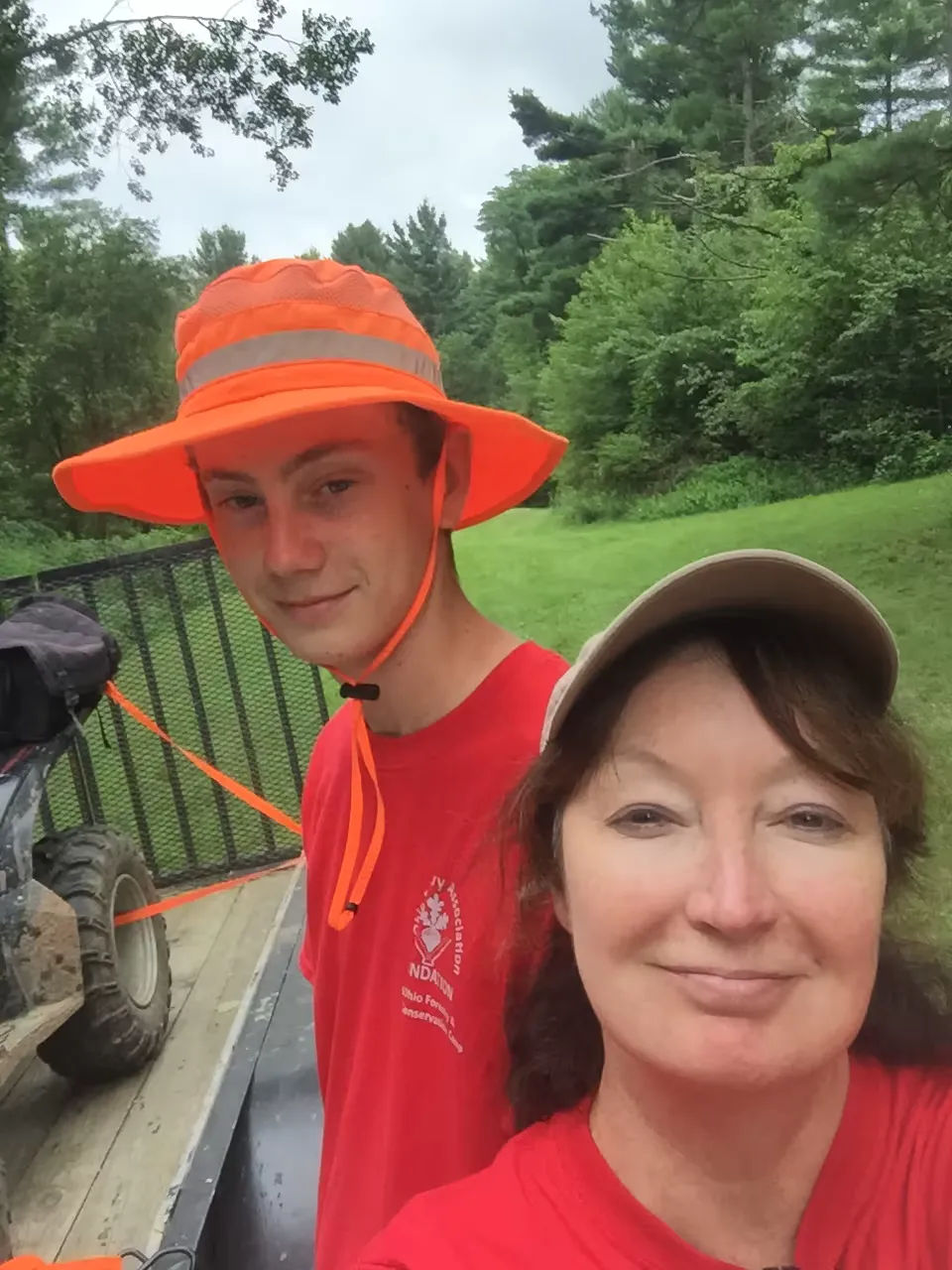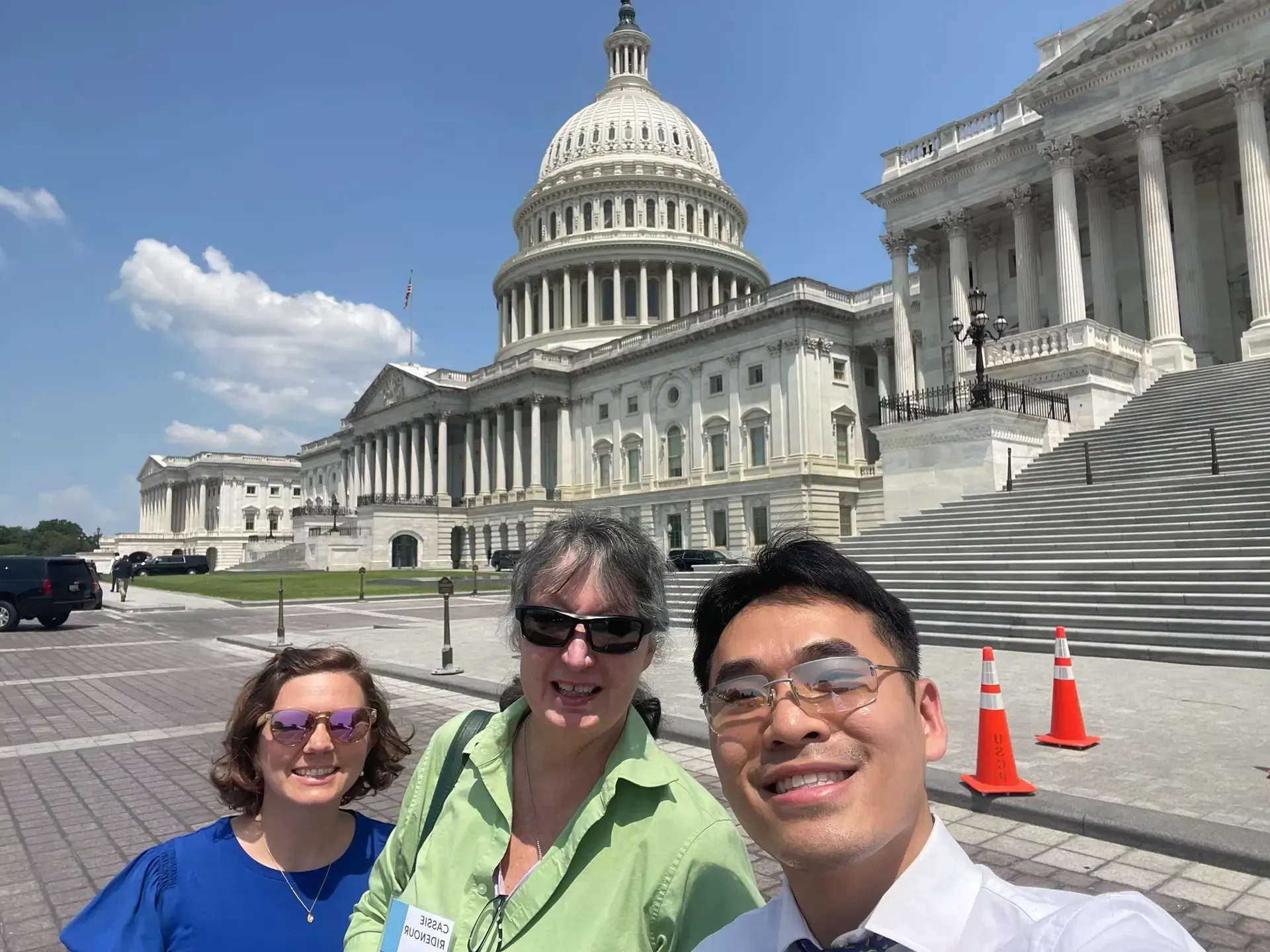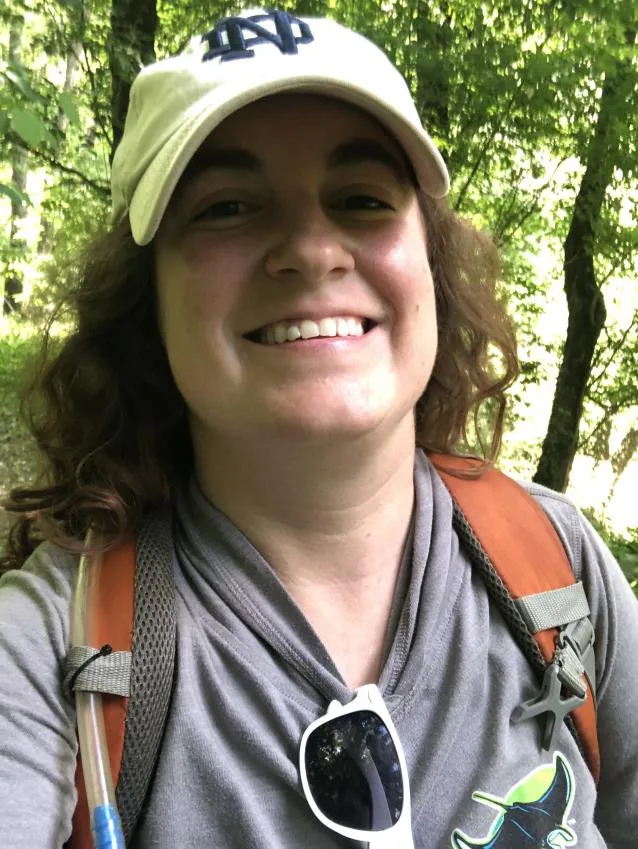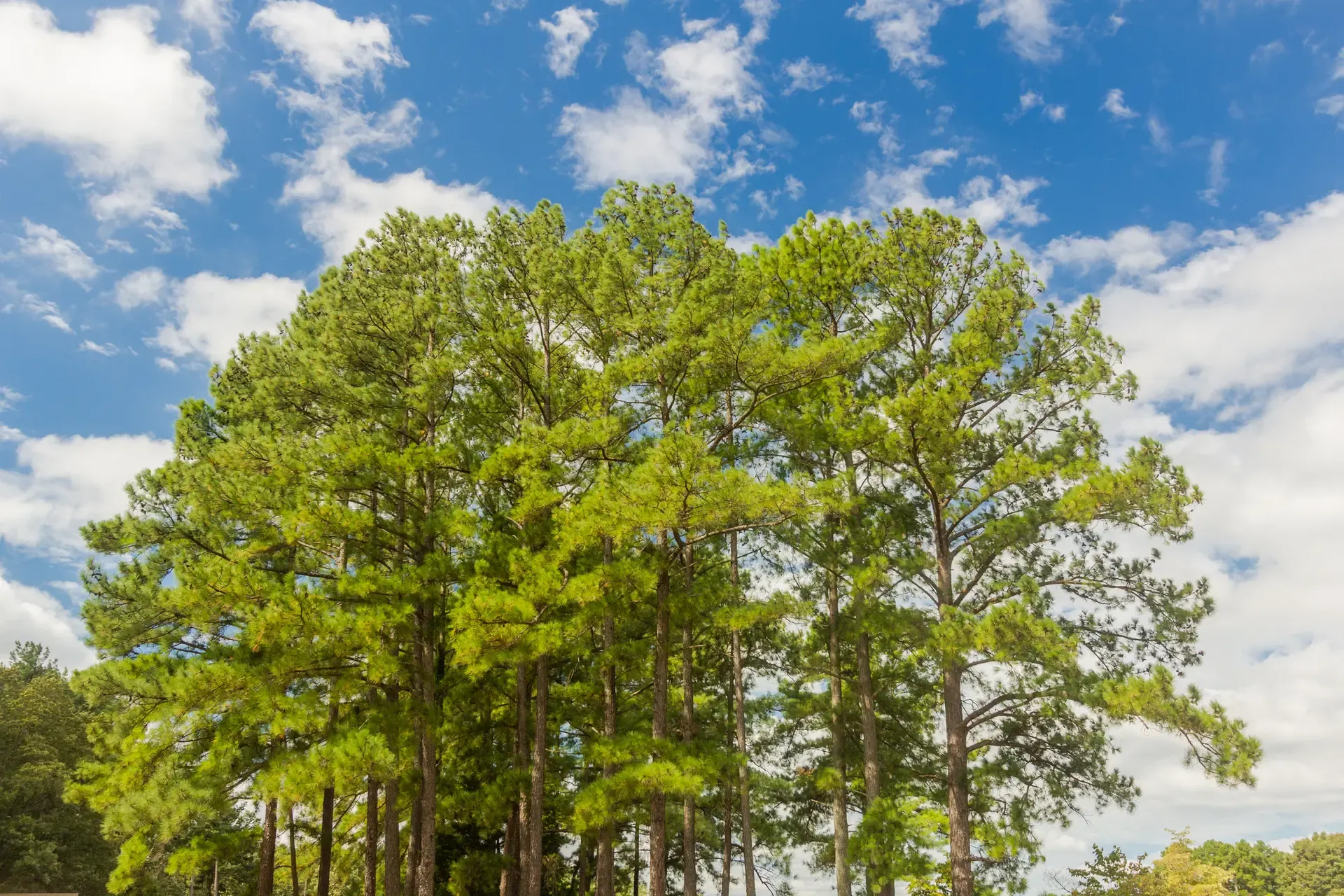Land Management Leads to Forest Advocacy: Cassie Ridenour’s Story
As Giving Tuesday nears, we want to highlight landowners who are doing the work in sustainable forest management. Whether giving their time, money, or experience, small private landowners are taking important steps across the nation to improve the health of their land. Cassie Ridenour learned to love forests from an early age. A photo taken when she was a toddler shows her pointing out a newly planted white pine seedling on her grandfather’s land in the Appalachian region of southeast Ohio. In the decades since, as those seedlings have matured, so has Cassie’s commitment to what is now her own forest property. Today, she both manages her land and advocates for sustainable forest management.
Cassie grew up in Akron, Ohio, a few hours’ drive from the 239 acres her grandfather Ed Clark purchased in Monroe County in 1963. “A lot of people at that time were buying an acre or two on the lake, and building a cabin there. But he realized he could buy more than 200 acres down there for what he would pay for two acres on the lake. So he decided to go for the bigger piece of property,” Cassie said. She spent time in the forest with her grandfather each year, camping on the land since the small cabin that’s now on the property wasn’t built until she was in her teens.
Cassie remained interested in forests and the environment during her high school years. She signed up for the environmental science career cluster that her school offered and attended a National Science Foundation summer program on aquatic ecosystems at Heidelberg College in Tiffin, Ohio. She continued to make trips to her grandfather's property as well.
When Cassie was in her late 20s, her grandfather began to talk about selling the land. “I told him, ‘Well, if you’re going to sell it, you have to sell it to me.’ This was a matter of great debate for about a year,” she said. “He would say things like, ‘You don’t even know how to use a chainsaw.’ So I said, ‘Okay, teach me how to use a chainsaw.’” When he finally agreed to the deal one weekend, she sent the down payment to him the following Monday.
“I look back and wonder why I thought it was important to spend that money down here when I was in my 20s,” she said. “I had some thoughts about doing some Christmas tree farming, but that never came to fruition. So I don’t know what was in my head except that I love the land."
Learning Land Management
The 239 acres of woodlands Cassie’s grandfather purchased included 104 acres of barren, abandoned farmland. During the 60s and 70s, working with Ohio’s forestry programs, he planted the barren land in white and red pines. He understood the importance of managing the property, pruned the trees, and took care of the land as needed. The healthy stands of white pines in this forest today reflect his efforts and Cassie’s continuation of his environmental stewardship.

Cassie and her son, Otto. Encouraging her son’s interest in the woodlands is another way that Cassie is preparing for the future.
Cassie said she learned a great deal about land management from her grandfather over the years. “He would tell me that these trees were going to be valuable someday, and that they would need to be commercially thinned. He gave me the name of the first forester that I worked with,” she said. “He would say, 'let the experts tell you how to manage the land.’”
Cassie notes that during her lifetime, the barren 104 acres have gone from no trees and zero board feet of lumber to 1 million board feet. Sometime next year, as she harvests 200 of the original white pines, she will be reaping some of the rewards of her grandfather’s and her efforts. The selected trees will yield about 55,000 feet of lumber, enough to build a few homes. In sharp contrast to this success story, some of the other forest owners who planted the white pines at the same time as her grandfather ended up bulldozing the trees or scrapping them out for pulpwood. The difference was sustainable land management.
“It’s a common misconception that if you do nothing, the forest will be just fine. That’s just not true. We have so many invasives, and if you just plant trees and don’t thin them they won’t get enough air. It’s like putting 1,000 people in a cafeteria meant for 100,” she added.
It’s become even more important these days to make forest owners aware of the need for land management. Cassie has seen a lot of the woodlands around her property change hands, and the purchasers are often professional people who haven’t previously owned forest properties. One way to introduce the newcomers to the concept of forest management is to educate them about the return on investment that well-maintained forest properties can bring.
“If people really look at their forests as assets and work on managing them responsibly, they can really create something of value, and that’s even without talking about the benefits of carbon sequestration,” Cassie added. When the environmental benefits are added into the equation, it’s even more obvious how sustainable land management pays off.
“It’s also just good for the soul,” she said.
Advocating for Family Forests
Cassie’s advocacy work on behalf of forests and their family owners has grown naturally from her love for the land. It’s also loosely connected to the time she spent with her grandfather; they would travel to county fairs and share stories and ideas about woodlands with representatives of the various forestry groups that were in attendance.
On one of these outings, Cassie met Walt Lange from Ohio’s Tree Farm program, and after talking with him, accepted his invitation to join the local committee.

Cassie standing with AFF staff, Bethany Mueller (right) and Calvin Tran (left), at the American Forest Foundation's annual Landowner Fly-In.
She eventually chaired the Ohio Tree Farm Committee. She’s now a member of the Governor’s Reclamation Commission, which looks into issues associated with reclamation of former mining lands in Ohio. “The commission needed someone with a knowledge of modern forestry techniques,” she explained.
Cassie began actively advocating for sustainable forestry around 10 years ago, when she made her first trip to Washington D.C. as part of an American Tree Farm System (ATFS) lobbying effort. It proved to be a turning point. “I took my son Otto, thinking it would be a good experience for him, but it ended up being super interesting for me, too,” Cassie said. In the last decade, she has learned a lot more about the federal farm bill, its significance for the forestry industry and the critical role that local family forest owners can play in securing its passage.
“I did not understand as much about how government works as I do now, or the importance and magnitude of the farm bill,” she said. “I’ve always known that people can influence policy, but I think I realize more and more that it really does make a difference.”
Cassie has been to D.C. twice since her initial visit, and has met one of Ohio’s U.S. senators and several of its representatives during her trips. She is an active advocate for forests at the state level as well. Last spring, she testified before the Ohio State legislature, urging them to provide continued funding for forestry programs in the state’s budget. “I’ve been excited to support AFF and their advocacy for family forest landowners and programs like the Family Forest Carbon Program expanding to places like Ohio," Cassie said.
As Giving Tuesday nears, please consider supporting the American Forest Foundation with a donation, which will help further the work landowners are doing in the mission for sustainable, climate friendly forest management.
One reason AFF asks family forest owners to participate in such advocacy efforts is that legislators need to hear from their constituents who actually own woodlands. “The farm bill is thousands of pages, and legislators really want to know how it affects their districts and the people who live there. So when you can have people from their constituencies who go to their legislators and say, “This is how it affected me,” it resonates. When talking with her state’s representatives, Cassie mentions that it is Ohio loggers who will cut down the trees on her property and that the wood from her forests will be used to build homes for people living in the state.
Cassie owns Cridenour.com, a management training, consulting, and auditing firm. As a statistician, she firmly believes that it’s important that forest advocates use data when making the case to elected officials and government employees for forestry programs. For example, in her presentation to the state legislature last spring, Cassie shared her own experience with forest management. She mentioned the more than one million board feet of white pine that her acreage now contains and the 5,000 tons of carbon the pines sequester. She noted that the trees on her property offset the emissions of more than 90 vehicles each year.
“AFF can assist family forest owners in receiving a forester visit, creating a forest management plan and working with them to access new markets, such as the voluntary carbon market and allow forests to come to healthy maturity to support our climate, forest products industry, our wildlife and help rural communities to thrive.”
Cassie has also spoken about all the other benefits that managing forests lands can bring: combatting climate change, promoting the forest products industry, and protecting wildlife and biodiversity in general. She noted that the state has 7.9 million acres of forestland, with 6.8 million acres owned by family forest owners. “The typical family forest owner is not wealthy and there have been several cases where family forests are sold to developers.” Since only 20% of forest owners in Ohio have sought advice on forest management advice, Cassie has encouraged government officials to tap into the opportunities offered by forest management through encouraging and supporting forest owners who want to learn more about managing their properties effectively. “AFF can assist them in receiving a forester visit, creating a forest management plan and working with them to access new markets, such as the voluntary carbon market, and allow forests to come to healthy maturity to support our climate, forest products industry, our wildlife and help rural communities to thrive.”
FFCP Provides Funding for Land Management
The advocacy efforts of family forest owners like Cassie Ridenour help AFF spread the word about the importance and benefits of forest management.” AFF’s Family Forest Carbon Program (FFCP) can connect landowners in 11 states with the resources that they need to do it.
FFCP provides family forest owners access to climate finance from carbon markets; they can help address climate change while earning income from their land. Since one of the program’s goals is improve the health of forests to sequester more carbon, participants get free assistance from forest management experts to develop land management plans for their properties.
Visit the Family Forest Carbon Program website for more information.
Plans for the Future
As she awaits the pine harvest, Cassie is focusing more of her own land management efforts on her property’s hardwood stands. “In general we are now managing for oak since it is such an important species for people and for wildlife. We did a mid-story removal for oak in 2019, and we’ve got another one planned in a year or two,” she said. The pine harvest will free up some space for oak and walnut seedlings as well.
Cassie has been able to do this work because of the funding she has received through the farm bill, specifically the Environmental Quality Incentive Program (EQIP). “I’ve had three EQIP contracts. The first was to get a management plan for the property in Monroe County; I now have some great data on my property,” she said. “The second contract was for the mid-story removal, cutting down some of the trees to create an opening channel. The third contract is for three years. We just completed the first year, doing an invasive species treatment underneath the pines we’ll be harvesting. So, when those trees are removed, the oaks and walnuts will be able to shoot up instead of the Ailanthus or privet,” she said.
Encouraging her son’s interest in the woodlands is another way that Cassie is preparing for the future. Otto has traveled with her to D.C. twice to advocate for sustainable forestry, attended Ohio’s Forestry Camp, Camp Canopy twice, and goes with her to the property each year to select the family Christmas tree. Both Otto and Cassie’s husband, Chris Cook, assist with the removal of invasive species. Chris recently dug a vernal pool (frog pond) on the property where they live in Muskingum County, and future plans include a pollinator garden as well as more tree planting.
Although Cassie is a busy business owner, she spends a dozen or more days in her woodlands each year, taking the lead role in caring for her property and helping it thrive. “It’s really an incredible journey if you have the patience for it,” she said. “I honestly don’t perceive myself as owning that land; I think at this point that land more or less owns me. I serve the land the best that I can.”
As Giving Tuesday nears, please consider supporting the American Forest Foundation with a donation, which will help further the work landowners are doing in the mission for sustainable, climate friendly forest management.
Related Articles

July 1, 2025
Forester Spotlight: Sarah Cawood
We’re excited to highlight Sarah Cawood, a dedicated forester with the Family Forest Carbon Program (FFCP) who brings enthusiasm, experience, and a strong commitment to conservation to her work.

June 3, 2025
Why Wildlife Loves Loblolly—And How These Pines Can Benefit Your Land
A quiet stretch of pine trees can offer more than just scenery—it can provide vital habitat for wildlife across every season. Loblolly pine, the most common native tree species in the Southeast, plays a particularly important role in creating habitat for a wide variety of game and non-game species, from wild turkeys and rabbits to songbirds and squirrels.

May 28, 2025
New Report Details Innovative Approach to Permanence for Natural Climate Solutions
The American Forest Foundation released today “A Trust for Permanence: Enabling a New Generation of Permanent Nature-Based Credits in the Voluntary Carbon Market,” a new concept paper that details an innovative approach to ensuring the quality and integrity of credits produced through natural climate solutions (NCS).